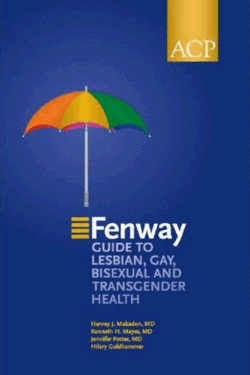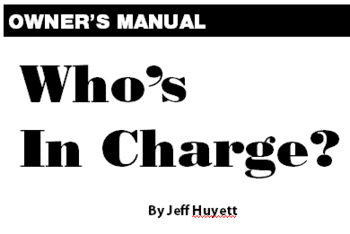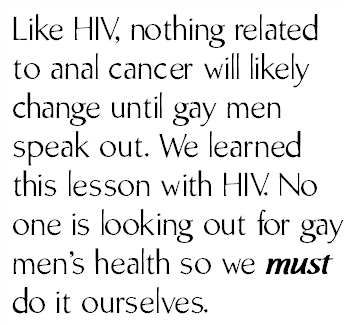 Fenway Guide to Lesbian, Gay, Bisexual,
Fenway Guide to Lesbian, Gay, Bisexual,
and Transgender Health American College of Physicians
ISBN-10: 193051395X
544 pages $54.95
Reviewed by Jeff Huyett, NP
A colleague asked if I would talk with a friend, also a nurse, about her college-age son who is “just out.” “Would you just talk with her about how to keep safe, which vaccinations to get and all that? Should he get an anal pap smear?” Working in a college environment in New York City, I play the role of homo-expert since I’m an “out, Queer nurse” who is also proficient in LGBTQQ health concerns. (I add QQ to cover “Queer and questioning,” too, as many folks will never fit into a neat and tidy box of sexual identification.) I take this seriously because formal education about sexual minority “health” is missing in most nursing and medical curricula. Mental health programs tend to lead in teaching professionals about particular LGBT health issues.
Mother’s fears about her son’s coming out are about his medical safety. As a health issue, sexually-transmitted disease risks and prevention are the focus of mainstream education about LGBT patients. So it’s typical she would see these as primary concerns for her son’s health. But, really, risk of diseases specific to LGBT sex are easy to obviate with measures like protected sex and preventive vaccines. Our medically modeled “healthcare system” focuses on diseases, though, not health. So, many health concerns of an LGBT patient will not be met in our current health care system.
I encouraged her to focus on the social and emotional issues her son will be faced with and not just the sex/safety. She knows that he is aging into a world that is still pretty hostile to Queers. She knows that her son will experience hateful conversations, slurs, taunting, and possible physical violence just for being Gay. His experiences will shape a worldview that will inform him and affect his health throughout life.
Or, maybe she doesn’t know this. That’s why the Fenway Guide to Lesbian, Gay, Bisexual, and Transgender Health is essential for anyone practicing healthcare. I say ‘anyone’ because every healthcare provider is likely to take care of someone who is not heterosexual at some point in their career.
This scholarly text takes a holistic view of the term “health” in the title. “Health” affected by self-concept, the people around you, the place you live, and the air you breathe. The reader learns about LGBT people, history, culture, sexual minority phobias, politics and the effects these have on individual health and well-being. Much of the information about living in environments of oppression, repression and stigma will be fresh and thought-provoking for the reader.
I write this review with great pleasure and respect for the Fenway Community Health Center in Boston and all the people who have been associated with it. Full disclosure: I practiced there for six years, during a time of expansion from a basement clinic to large, multi-service health center in a state-of-the-art facility. It all happened as AIDS raged around us. Fenway endures and advances the LGBT health movement for all of us, not just Boston. Those times and this “model” of care permeate my own caregiving, teaching, research, and political activism.
Like the few other urban LGBT health services, Fenway came into being because men having Gay sex didn’t have a comfortable place to get checked and treated for sexually transmitted infections. Most communities forming post-Stonewall realized that “out” people had difficulty finding any kind of health care that was welcoming. The emergence of HIV further compounded the deficiencies of a mainstream system to care for sexual minorities. The fact that Fenway is expanding again exemplifies that specific agencies are still needed for LGBT health. The mainstream health care system still doesn’t get it. I advise corporate health executives, managers, and industry leaders: read this book. You are TOTALLY missing our market niche when it comes to LGBT health care.
For most clinicians, the Fenway Guide will fill in virtually all the information gaps about LGBT health. The style is scholarly, with footnoting and referencing. It reads like a textbook for a really interesting class. Each chapter reviews current scientific literature and synthesizes the findings into cogent practice recommendations for medical, nursing and mental health clinicians. Authors provide community and professional organizations information, websites, and resources. Sample intake forms, patient handouts, and health proxy forms are provided in the appendix for reader use in the clinical setting. Scientific literature and clinical recommendations will help clinicians to shape programs, staff offices, and provide care that is evidence-based. There are facts, figures, statistics and charts to highlight areas of strengths and deficiencies in programs. The 544-page text is a tome, but I cannot find information to edit, because, frankly, this is a primer, a beginner course. It is Queer health essentials.
The authors are physicians, social workers, psychologists, therapists, public health, health education professionals, lawyers and a physician’s assistant. These LGBT health experts practice in a variety of settings around the country, but most are from Boston. Some are in Gay-identified health service organizations similar to Fenway. Others are “out” and working in universities, hospitals, government agencies and grassroots organizations. Most of the authors are involved in ground-breaking research and community development. They acknowledge the extreme lack of population-based evidence of LGBT-particular health needs to guide us scientifically. They reinforce the clinician’s need to practice the “art of medicine” as stated in the preface by the editors. The term “art of healing” would have been more inclusive and better reflect the wide array of disciplines represented by the authors involved in this ground-breaking book.
This brings up my biggest criticism: there is a lack of nurse authors in the contributor list, though nurses are mentioned in the reading. This glaring omission demonstrates how nursing is reflected, or not, in the medical community, especially on the East Coast. Nurses have had great impact in the development of a wide array of LGBT services across the country.
Most authors use case studies to illustrate particular health topics. Many clinicians will be shocked when reading stories of coming out, abandonment, violence, and flat-out rejection by parents, family, friends and health care providers. Clinicians will learn how to better interpret the effects of oppression and stigma on individual health. This learning can readily be transposed to any care provided trans-culturally to assess the health affects of minority status. Effective history taking is reviewed in detail. Concrete examples are given for language and question formation to improve patient encounters, engender trust, and enhance the patient-provider relationship. The tone is matter-of-fact when it comes to discussing drug use, fetishes, and sexual behaviors. Especially important, the book reviews the need for sensitivity development in non-clinical staff as well as providing a safe, welcoming office environment for LGBT patients. Suggestions include LGBT representation in artwork, education materials, forms and questionnaires.
Families are explored from chosen families, bearing and raising children, Queer kids in straight families, and the notion that American families are just plain changing. LGBT folks are well aware of the importance of our close-knit circle of friends or chosen family. Fenway Guide carefully illustrates how society and laws dishonor these families. It teaches the clinician how to explore this realm with a patient to provide care to all who are family. Clinicians can use draft health proxy and living will forms to legally document the patient’s wishes in their medical record. The paradox is that America professes “family” as a core value, and yet we dismiss so much of what family is or can be.
Bearing and raising children happens in a variety of ways for parents in LGBT communities. The complexities of our couplings, alternative insemination, and the realities of raising children in same-sex-parent families is taught with census data, clinical research, and case studies. Like so much of this book, the discussions are full of examples from clinical experiences. I found this imparted a human-ness to the repeated statistics and study regurgitation. From a learner’s standpoint, I found this a good way to acculturate clinicians to the realities of Queer people.
Readings about transgender health are new and insightful. The reader will have a better understanding of the psychological, emotional, and cultural underpinnings of being transgender. This text does not outline methods of cross-gender hormone therapy but refers the reader to other resources. Given the lack of evidence-based research in cross-gender hormone therapy, the editors avoid recommendations about pharmacological measures. This reflects the reluctance of agencies to incur liability for recommendations in light of a lack of research. There is ample overview of hormone management and side effects monitoring as well as methods of surgical interventions for feminization and masculinization.
The Guide discusses physical, emotional, and familial experiences of people with disorders of sexual development (DSD) or intersex patients. This helpful chapter guides the family and clinician in the difficult decision making when it comes to treatment of infants with hormone therapy when there is ambiguous genital formation.
Evidence and recommendations for screening, treating and preventing sexually-transmitted infections are well provided. The specifics of HIV care are abbreviated, given the constant emergence of new studies. The reader is referred to current scientific guidelines and literature regarding HIV treatment specifics.
When a clinician wants to initiate practice changes in a health care environment, they must present documented need and proven methods of improvement. Getting clinicians to perform new behaviors or interview techniques is typically met with groans of “I’m already so busy. How will I have time to ask that or do this?” The Guide recognizes the over-worked, stressful environment that is health care today. Feasible suggestions are made for practice improvement, with average times given for elements of an interview or intervention. This allows the clinician to see how to integrate practice changes into the “ten-minute office visit.” There is ample discussion about the LGBT provider, navigation of coming out in the system, staying out, and helping colleagues with the coming-out process. The Guide is not simplistic about the value and risk still inherent in being out in today’s health care environment. There are good legal, professional, educational, and support resources.
Health care professionals and consumers alike must take the opportunity to educate with this book. We recommend it for coursework in universities, libraries in health care institutions, and reference book shelves in offices everywhere. Similarly, we challenge organizations to develop non-discrimination policies in practice and employment. The Guide gives helpful suggestions for doing this.
This book can shape a paradigm for health care that is sensitive to our needs as patients and as people. The majority of LGBT patients and clinicians will not have access to the resources offered in urban centers. Therefore, all clinicians need to develop an LGBT health care vocabulary because we are everywhere.
And I have to tell you, I love the rainbow umbrella on the cover.
This is just an excerpt from this issue of White Crane. We are a reader-supported journaland need you to subscribe to keep this conversation going. So to read more from this wonderful issue SUBSCRIBE to White Crane. Thanks!
Jeff Huyett is a contributing editor to White Crane and a nurse practitioner in NYC. His clinical work has primarily been in Queer Health with a focus on HIV, rectal and Transgender care. He is the Radical Faerie Daisy Shaver and is involved with the development of Faerie Camp Destiny Radical Sanctuary in Vermont. He can be reached at JeffANP@aol.com. He writes the "Owner’s Manual" health column in each issue.



